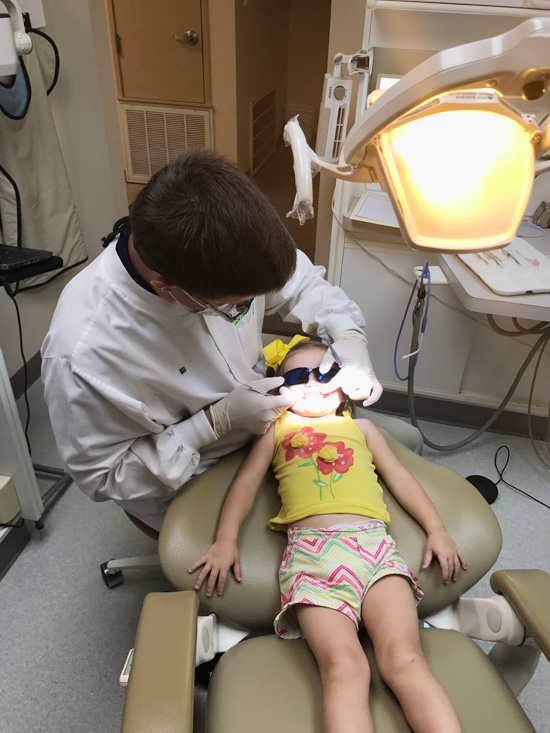Q. “My name is Lee, and I’m a 32-year-old computer science engineer. Recently, I’ve been experiencing pain and discomfort when I eat sweets or very cold foods. What can I do to decrease tooth sensitivity?”
A. Pain from sensitive teeth is not always constant; it can come and go. Constant pain could be a sign of a more serious problem. It is still important, however, to discuss your symptoms with your dentist to determine the cause and proper treatment.
In healthy teeth, porous tissue called dentin is protected by your gums and by your tooth’s hard enamel shell. Microscopic holes in the dentin, called tubules, connect to the nerve, triggering pain when irritated by certain foods and beverages. Depending on the diagnosis, your dentist may recommend one or more of the following treatments to relieve the symptoms of sensitive teeth:
- A soft-bristle toothbrush, or a powered brush to protect gums.
- A study has shown that a powered brush, like a Sonicare Toothbrush, can be as gentle as a manual toothbrush.
- A fluoride rinse or gel for sensitive teeth, prescribed by your dentist.
- A desensitizing toothpaste, like Sensodyne Pronamel Toothpaste.

“How can I keep my mouth healthy?”
Q. “My name is Savannah and I’m 11. I try to take care of my teeth, but I also like to eat candy and sometimes I forget to brush. How can I keep my teeth from getting cavity bugs?”
A. Savannah, that’s a great question! First, it is okay to eat a little bit of candy and sweets but it is very important that you make sure you brush your teeth every morning and at night right before you go to bed. After you brush them at bedtime try not to eat or drink anything except water, so your teeth will be super clean while you are sleeping to help keep germs off of them. You should brush for 2 minutes each morning after breakfast. At bedtime, floss and then brush your teeth for 2 minutes!
Children’s teeth begin forming before birth. As early as 4 months, the first primary, or baby teeth, erupt through the gums. All 20 of the primary teeth usually appear by age 3, although their pace and order of eruption varies. Permanent teeth begin appearing around age 6. This process continues until approximately age 21.
To help ensure oral health and a lifetime of good oral care habits:
- Limit children’s sugar intake
- Make sure children get enough fluoride, whether through drinking water or as a treatment at the dentist’s office.
- Teach children how to brush and floss correctly.
- Supervise brushing sessions and help with flossing, which can be a challenge for small hands.

More Customer Questions
Q. “What are crowns and why are they used?”
A. A crown is a restoration that covers, or caps, a tooth to restore it to its normal shape and size. Its purpose is to strengthen or improve the appearance of a tooth. A crown is placed for a number of reasons:
- To support a large filling when there isn’t enough tooth remaining.
- To attach a bridge.
- To protect weak teeth from fracturing.
- To restore fractured teeth.
- To cover badly shaped or discolored teeth.
- To cover a dental implant.
Q. “What is scaling and root planing?”
A. Periodontal Scaling and Root Planing is the treatment of the diseased root surfaces below the gum line. A routine cleaning emphasizes cleaning teeth above the gum line in a healthy mouth. Root Planing focuses on eliminating tarter and plaque below the gum and detoxifying the root surfaces where the disease occurs. Obtaining smooth roots and flushing out the pockets with a medicated rinse allows for a healthy reattachment of the gums to the root surfaces.
Periodontal treatment recommendations do not cure this disease, but attempt to control the disease process from causing more destruction. The dentist and the dental hygienist cannot control the disease by themselves.
Q. “What tips should I know for my infant’s teeth?”
A. Here are some helpful tips for new parents and caregivers.
- Schedule regular dental visits beginning by the child’s first birthday.
- Put only water in a bottle that’s used at naptime or bedtime.
- Ask your dentist about how to get the right amount of fluoride for your growing child.
- Provide your child with a balanced diet.
- Start brushing as soon as the child’s first tooth appears.
- Brush and floss your child’s teeth daily until the child can be taught to do this alone.
- Ask your dentist about sealants.

